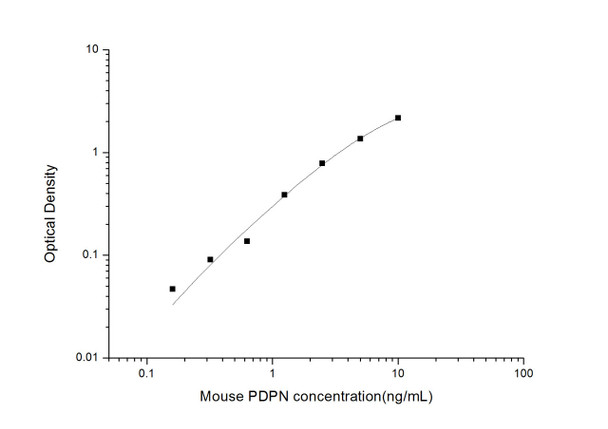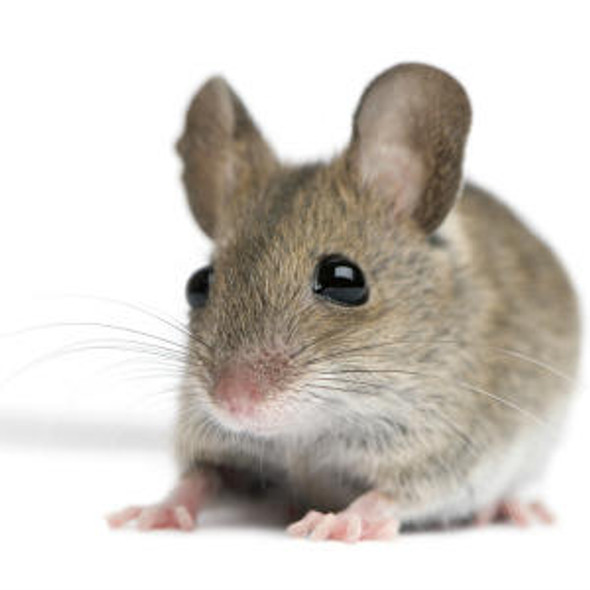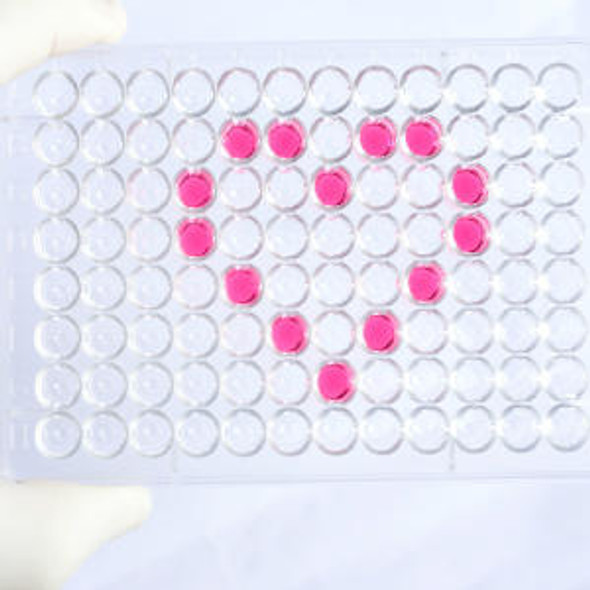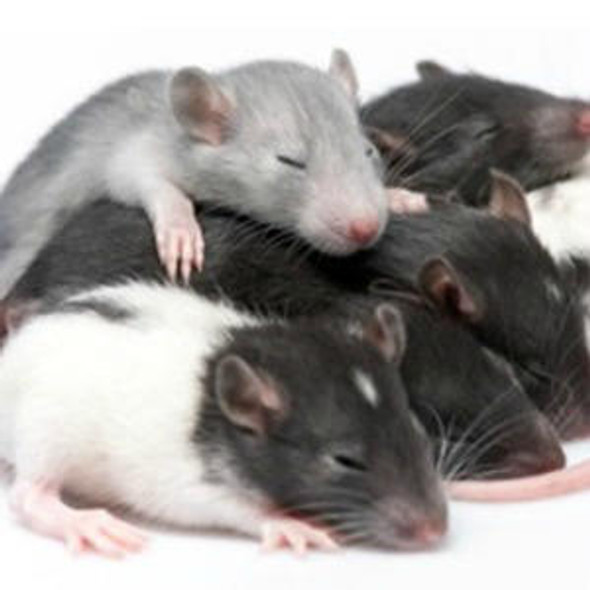Mouse Cell Biology ELISA Kits 2
Mouse PDPN (Podoplanin) ELISA Kit (MOES01690)
- SKU:
- MOES01690
- Product Type:
- ELISA Kit
- Size:
- 96 Assays
- Uniprot:
- Q62011
- Sensitivity:
- 0.09ng/mL
- Range:
- 0.16-10ng/mL
- ELISA Type:
- Sandwich
- Reactivity:
- Mouse
- Sample Type:
- Serum, plasma and other biological fluids
- Research Area:
- Cell Biology
Description
| Assay type: | Sandwich |
| Format: | 96T |
| Assay time: | 4.5h |
| Reactivity: | Mouse |
| Detection Method: | Colormetric |
| Detection Range: | 0.16-10 ng/mL |
| Sensitivity: | 0.10 ng/mL |
| Sample Volume Required Per Well: | 100µL |
| Sample Type: | Serum, plasma and other biological fluids |
| Specificity: | This kit recognizes Mouse PDPN in samples. No significant cross-reactivity or interference between Mouse PDPN and analogues was observed. |
This ELISA kit uses Sandwich-ELISA as the method. The micro ELISA plate provided in this kit has been pre-coated with an antibody specific to Mouse PDPN. Standards or samples are added to the appropriate micro ELISA plate wells and combined with the specific antibody. Then a biotinylated detection antibody specific for Mouse PDPN and Avidin-Horseradish Peroxidase (HRP) conjugate are added to each micro plate well successively and incubated. Free components are washed away. The substrate solution is added to each well. Only those wells that contain Mouse PDPN, biotinylated detection antibody and Avidin-HRP conjugate will appear blue in color. The enzyme-substrate reaction is terminated by adding Stop Solution and the color turns yellow. The optical density (OD) is measured spectrophotometrically at a wavelength of 450 nm ± 2 nm. The OD value is proportional to the concentration of Mouse PDPN. The concentration of Mouse PDPN in samples can be calculated by comparing the OD of the samples to the standard curve.
| UniProt Protein Function: | Mediates effects on cell migration and adhesion through its different partners. During development plays a role in blood and lymphatic vessels separation by binding CLEC1B, triggering CLEC1B activation in platelets and leading to platelet activation and/or aggregation (PubMed:14522983, PubMed:15231832, PubMed:20110424, PubMed:17616532). Interaction with CD9, on the contrary, attenuates platelet aggregation and pulmonary metastasis induced by PDPN. Mediates effects on cell migration and adhesion through its different partners. Through MSN or EZR interaction promotes epithelial-mesenchymal transition (EMT) leading to ERZ phosphorylation and triggering RHOA activation leading to cell migration increase and invasiveness. Interaction with CD44 promotes directional cell migration in epithelial and tumor cells. In lymph nodes (LNs), controls fibroblastic reticular cells (FRCs) adhesion to the extracellular matrix (ECM) and contraction of the actomyosin by maintaining ERM proteins (EZR; MSN and RDX) and MYL9 activation through association with unknown transmembrane proteins. Engagement of CLEC1B by PDPN promotes FRCs relaxation by blocking lateral membrane interactions leading to reduction of ERM proteins (EZR; MSN and RDX) and MYL9 activation (PubMed:25347465). Through binding with LGALS8 may participate to connection of the lymphatic endothelium to the surrounding extracellular matrix. In keratinocytes, induces changes in cell morphology showing an elongated shape, numerous membrane protrusions, major reorganization of the actin cytoskeleton, increased motility and decreased cell adhesion (PubMed:10574709). Controls invadopodia stability and maturation leading to efficient degradation of the extracellular matrix (ECM) in tumor cells through modulation of RHOC activity in order to activate ROCK1/ROCK2 and LIMK1/LIMK2 and inactivation of CFL1. Required for normal lung cell proliferation and alveolus formation at birth (PubMed:12654292). Does not function as a water channel or as a regulator of aquaporin-type water channels. Does not have any effect on folic acid or amino acid transport (PubMed:12032185). |
| UniProt Code: | Q62011 |
| NCBI GenInfo Identifier: | 595763348 |
| NCBI Gene ID: | 14726 |
| NCBI Accession: | NP_001277751. 1 |
| UniProt Secondary Accession: | Q62011,Q546R8, Q61612, A2A8J3, |
| UniProt Related Accession: | Q62011 |
| Molecular Weight: | 18,233 Da |
| NCBI Full Name: | podoplanin isoform 2 |
| NCBI Synonym Full Names: | podoplanin |
| NCBI Official Symbol: | Pdpn |
| NCBI Official Synonym Symbols: | E11; T1a; Gp38; OTS-8; T1alpha; RANDAM-2; T1-alpha |
| NCBI Protein Information: | podoplanin |
| UniProt Protein Name: | Podoplanin |
| UniProt Synonym Protein Names: | Glycoprotein 38 |
| Protein Family: | Podoplanin |
| UniProt Gene Name: | Pdpn |
As the OD values of the standard curve may vary according to the conditions of the actual assay performance (e. g. operator, pipetting technique, washing technique or temperature effects), the operator should establish a standard curve for each test. Typical standard curve and data is provided below for reference only.
| Concentration (ng/mL) | O.D | Average | Corrected |
| 10 | 2.23 2.248 | 2.239 | 2.162 |
| 5 | 1.413 1.457 | 1.435 | 1.358 |
| 2.5 | 0.877 0.849 | 0.863 | 0.786 |
| 1.25 | 0.458 0.472 | 0.465 | 0.388 |
| 0.63 | 0.218 0.21 | 0.214 | 0.137 |
| 0.32 | 0.169 0.167 | 0.168 | 0.091 |
| 0.16 | 0.119 0.129 | 0.124 | 0.047 |
| 0 | 0.07 0.084 | 0.077 | -- |
Precision
Intra-assay Precision (Precision within an assay): 3 samples with low, mid range and high level Mouse PDPN were tested 20 times on one plate, respectively.
Inter-assay Precision (Precision between assays): 3 samples with low, mid range and high level Mouse PDPN were tested on 3 different plates, 20 replicates in each plate.
| Intra-assay Precision | Inter-assay Precision | |||||
| Sample | 1 | 2 | 3 | 1 | 2 | 3 |
| n | 20 | 20 | 20 | 20 | 20 | 20 |
| Mean (ng/mL) | 0.54 | 1.36 | 4.78 | 0.55 | 1.26 | 5.09 |
| Standard deviation | 0.04 | 0.06 | 0.25 | 0.04 | 0.06 | 0.27 |
| C V (%) | 7.41 | 4.41 | 5.23 | 7.27 | 4.76 | 5.30 |
Recovery
The recovery of Mouse PDPN spiked at three different levels in samples throughout the range of the assay was evaluated in various matrices.
| Sample Type | Range (%) | Average Recovery (%) |
| Serum (n=5) | 91-103 | 96 |
| EDTA plasma (n=5) | 94-107 | 101 |
| Cell culture media (n=5) | 90-106 | 97 |
Linearity
Samples were spiked with high concentrations of Mouse PDPN and diluted with Reference Standard & Sample Diluent to produce samples with values within the range of the assay.
| Serum (n=5) | EDTA plasma (n=5) | Cell culture media (n=5) | ||
| 1:2 | Range (%) | 96-114 | 94-109 | 91-105 |
| Average (%) | 104 | 99 | 99 | |
| 1:4 | Range (%) | 94-108 | 83-96 | 83-96 |
| Average (%) | 100 | 89 | 89 | |
| 1:8 | Range (%) | 94-107 | 80-93 | 83-98 |
| Average (%) | 99 | 86 | 90 | |
| 1:16 | Range (%) | 94-105 | 83-96 | 85-98 |
| Average (%) | 99 | 88 | 90 |
An unopened kit can be stored at 4°C for 1 month. If the kit is not used within 1 month, store the items separately according to the following conditions once the kit is received.
| Item | Specifications | Storage |
| Micro ELISA Plate(Dismountable) | 8 wells ×12 strips | -20°C, 6 months |
| Reference Standard | 2 vials | |
| Concentrated Biotinylated Detection Ab (100×) | 1 vial, 120 µL | |
| Concentrated HRP Conjugate (100×) | 1 vial, 120 µL | -20°C(shading light), 6 months |
| Reference Standard & Sample Diluent | 1 vial, 20 mL | 4°C, 6 months |
| Biotinylated Detection Ab Diluent | 1 vial, 14 mL | |
| HRP Conjugate Diluent | 1 vial, 14 mL | |
| Concentrated Wash Buffer (25×) | 1 vial, 30 mL | |
| Substrate Reagent | 1 vial, 10 mL | 4°C(shading light) |
| Stop Solution | 1 vial, 10 mL | 4°C |
| Plate Sealer | 5 pieces | |
| Product Description | 1 copy | |
| Certificate of Analysis | 1 copy |
- Set standard, test sample and control (zero) wells on the pre-coated plate and record theirpositions. It is recommended to measure each standard and sample in duplicate. Note: addall solutions to the bottom of the plate wells while avoiding contact with the well walls. Ensuresolutions do not foam when adding to the wells.
- Aliquot 100µl of standard solutions into the standard wells.
- Add 100µl of Sample / Standard dilution buffer into the control (zero) well.
- Add 100µl of properly diluted sample (serum, plasma, tissue homogenates and otherbiological fluids) into test sample wells.
- Cover the plate with the sealer provided in the kit and incubate for 90 min at 37°C.
- Aspirate the liquid from each well, do not wash. Immediately add 100µL of BiotinylatedDetection Ab working solution to each well. Cover the plate with a plate seal and gently mix. Incubate for 1 hour at 37°C.
- Aspirate or decant the solution from the plate and add 350µL of wash buffer to each welland incubate for 1-2 minutes at room temperature. Aspirate the solution from each well andclap the plate on absorbent filter paper to dry. Repeat this process 3 times. Note: a microplatewasher can be used in this step and other wash steps.
- Add 100µL of HRP Conjugate working solution to each well. Cover with a plate seal andincubate for 30 min at 37°C.
- Aspirate or decant the solution from each well. Repeat the wash process for five times asconducted in step 7.
- Add 90µL of Substrate Reagent to each well. Cover with a new plate seal and incubate forapproximately 15 min at 37°C. Protect the plate from light. Note: the reaction time can beshortened or extended according to the actual color change, but not by more than 30min.
- Add 50 µL of Stop Solution to each well. Note: Adding the stop solution should be done inthe same order as the substrate solution.
- Determine the optical density (OD value) of each well immediately with a microplate readerset at 450 nm.






